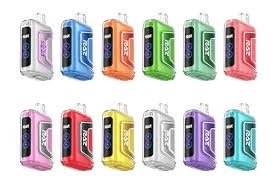With so many e-cigarette brands on the market, finding the "safest" one can feel impossible. Which brands prioritize safety and minimize harm?
There is no "safest" e-cigarette brand, as vaping inherently carries risks. However, some brands prioritize safety features, transparent ingredient lists, and third-party testing, which may make them "less harmful" than others. Look for brands with a good reputation, clear labeling, and compliance with safety standards.
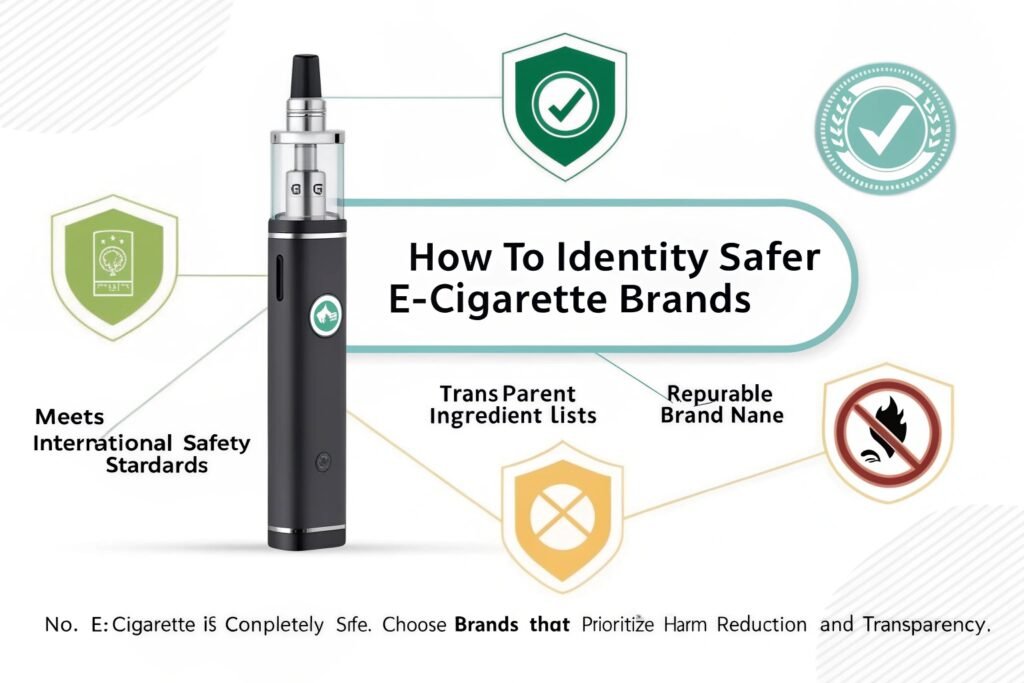 "A collage of e-cigarette brands showcasing their safety certifications and features"
"A collage of e-cigarette brands showcasing their safety certifications and features"
As someone who's been in the vape industry, I know that navigating this landscape can be tricky. Let's explore what to look for in a potentially "less harmful" e-cigarette brand.
Which vape brand is the least harmful?
Finding the "least harmful" vape brand requires careful evaluation.
**Determining the "least harmful" vape brand is difficult due to the inherent risks of vaping. However, brands that invest in research, development, and quality control may be considered "less harmful." Look for brands with:
- Transparent ingredient lists
- Third-party testing
- Compliance with regulations
- Focus on safety features.**
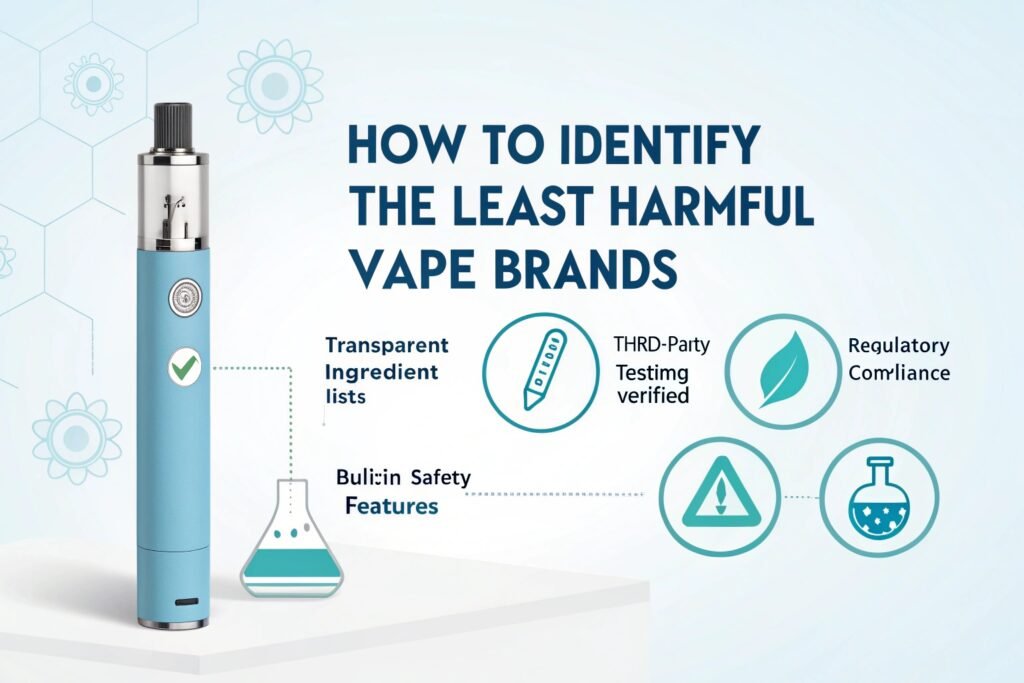 "A vape brand highlighting its investment in research, development, and quality control"
"A vape brand highlighting its investment in research, development, and quality control"
It's essential to remember that no vape is entirely safe, but some brands take more precautions than others.
The criteria for evaluating the safety and harm reduction potential of e-cigarette brands are multifaceted, encompassing product design, manufacturing processes, and marketing practices. Drawing from my understanding of product safety regulations and public health principles, I've identified the following key considerations. The transparency of ingredients and manufacturing processes1 allows consumers to make informed choices – brands that are transparent about their ingredients and manufacturing processes build trust with consumers and allow them to make informed choices about the products they use. The compliance with safety standards and regulations ensures product quality and consistency – compliance with safety standards and regulations, such as those set by the FDA or EU, ensures product quality and consistency, protecting consumers from potentially harmful products. The investment in research and development to improve product safety and reduce harm – brands that invest in research and development to improve product safety and reduce harm demonstrate a commitment to minimizing the risks associated with vaping. The implementation of quality control measures to prevent contamination and ensure product consistency – implementing quality control measures to prevent contamination and ensure product consistency safeguards consumers from exposure to harmful substances. The responsible marketing practices that avoid targeting youth and promoting misleading health claims – responsible marketing practices that avoid targeting youth and promoting misleading health claims help prevent the initiation of vaping among young people and ensure that consumers are not misled about the potential health benefits of vaping.
The factors that may contribute to a lower risk profile for certain e-cigarette brands include the use of high-quality components, the implementation of safety features, and the adherence to strict manufacturing standards. Through analyzing product specifications and safety reports, I've identified the following key attributes. The use of high-quality components, such as batteries and heating elements, reduces the risk of malfunctions and explosions – using high-quality components, such as batteries and heating elements, reduces the risk of malfunctions and explosions, ensuring a safer vaping experience. The implementation of safety features, such as temperature control and overcharge protection, prevents overheating and battery damage – implementing safety features, such as temperature control and overcharge protection, prevents overheating and battery damage, minimizing the risk of fire or injury. The adherence to strict manufacturing standards, such as ISO or GMP certifications, ensures product quality and consistency – adhering to strict manufacturing standards, such as ISO or GMP certifications, ensures product quality and consistency, protecting consumers from exposure to harmful substances. The transparent labeling and ingredient disclosure allow consumers to make informed choices – transparent labeling and ingredient disclosure allow consumers to make informed choices about the products they use, enabling them to avoid ingredients they may be allergic to or concerned about. The third-party testing and certifications2 validate the safety claims and quality of the product – third-party testing and certifications validate the safety claims and quality of the product, providing consumers with assurance that the product has been independently tested and verified.
The importance of considering individual risk factors and consulting with healthcare professionals3 when making decisions about e-cigarette use cannot be overstated. Through analyzing public health guidelines and expert recommendations, I've identified the following key considerations. The individual risk factors, such as age, pre-existing health conditions, and smoking history, influence the potential harms of e-cigarette use – individual risk factors, such as age, pre-existing health conditions, and smoking history, influence the potential harms of e-cigarette use, with certain populations being more vulnerable to adverse health effects. The consulting with healthcare professionals allows individuals to receive personalized advice based on their specific health needs and risk factors – consulting with healthcare professionals allows individuals to receive personalized advice based on their specific health needs and risk factors, enabling them to make informed decisions about e-cigarette use. The healthcare professionals can provide guidance on smoking cessation strategies and alternative nicotine replacement therapies – healthcare professionals can provide guidance on smoking cessation strategies and alternative nicotine replacement therapies, helping smokers quit smoking without resorting to e-cigarettes. The staying informed about the latest research and safety recommendations is crucial for making informed decisions – staying informed about the latest research and safety recommendations from reputable sources, such as the CDC and NIH, is crucial for making informed decisions about e-cigarette use. The ultimately, quitting smoking or vaping is the best option for long-term health – ultimately, quitting smoking or vaping is the best option for long-term health, as it eliminates the risks associated with nicotine addiction and exposure to harmful chemicals.
Are there 100% safe vapes?
The reality is that no vape is entirely risk-free.
No, there are no 100% safe vapes. Vaping involves inhaling aerosols that can contain harmful chemicals, even if the e-liquid is nicotine-free. While some vapes may be "less harmful" than others, they all carry some level of risk.
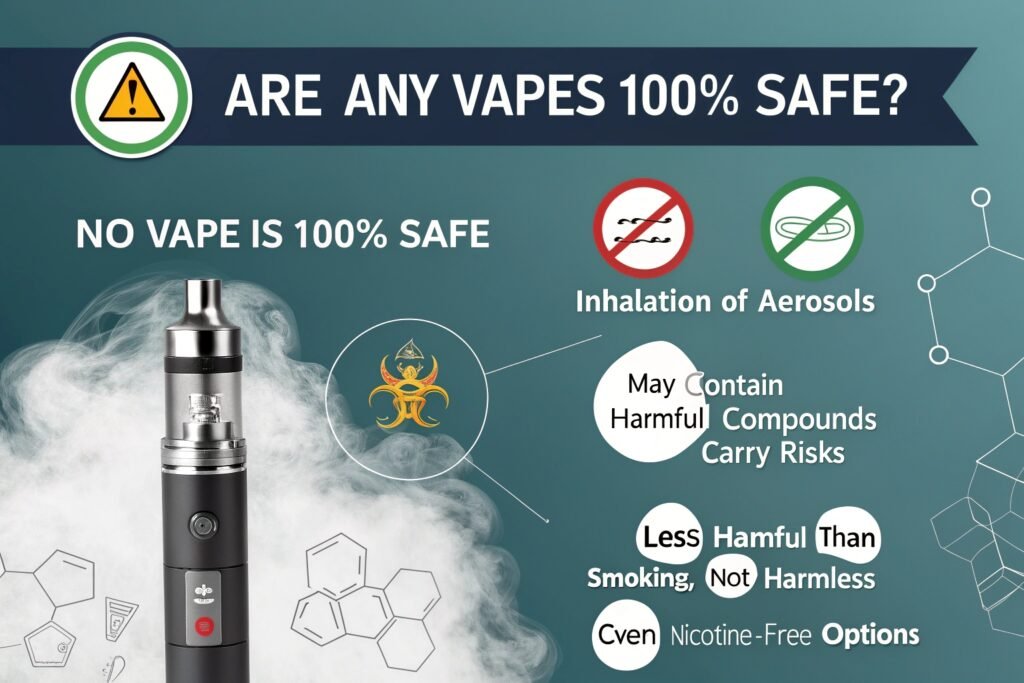 "A warning label emphasizing that vaping is not a safe alternative to smoking and carries inherent risks"
"A warning label emphasizing that vaping is not a safe alternative to smoking and carries inherent risks"
It's important to understand that vaping is not a harmless activity.
The potential health risks associated with vaping, even with supposedly "safe" devices, are multifaceted and encompass respiratory, cardiovascular, and neurological effects. Drawing from my understanding of toxicology and public health, I've identified the following key concerns. The exposure to harmful chemicals4, such as formaldehyde and acrolein, can damage the respiratory system – vaping, even with supposedly "safe" devices, exposes users to harmful chemicals, such as formaldehyde and acrolein, which can damage the respiratory system and increase the risk of lung disease. The nicotine addiction5 can lead to dependence and withdrawal symptoms – even if the device is marketed as "safe," nicotine addiction can lead to dependence and withdrawal symptoms, such as cravings, irritability, and anxiety. The unknown long-term effects of vaping on the cardiovascular system and brain are concerning – the long-term effects of vaping on the cardiovascular system and brain are still largely unknown, raising concerns about potential long-term health consequences. The vaping can exacerbate pre-existing respiratory conditions, such as asthma and COPD – vaping can exacerbate pre-existing respiratory conditions, such as asthma and COPD, leading to increased symptoms and reduced quality of life. The vaping is not a safe alternative to smoking and may lead to dual use – vaping is not a safe alternative to smoking and may lead to dual use, where individuals continue to smoke cigarettes while also vaping, increasing their overall exposure to harmful substances.
The limitations of current research on the long-term health effects of vaping6 highlight the need for caution and further investigation. Through analyzing scientific literature and expert opinions, I've identified the following key limitations. The limited duration of studies makes it difficult to assess the long-term health effects of vaping – the limited duration of studies makes it difficult to assess the long-term health effects of vaping, as many chronic diseases take years or decades to develop. The lack of standardized vaping products and practices makes it challenging to compare study results – the lack of standardized vaping products and practices makes it challenging to compare study results, as different devices and e-liquids may have different health effects. The potential for confounding factors, such as smoking history and pre-existing health conditions, complicates the interpretation of study findings – the potential for confounding factors, such as smoking history and pre-existing health conditions, complicates the interpretation of study findings, making it difficult to isolate the specific effects of vaping. The ethical considerations limit the ability to conduct randomized controlled trials on the health effects of vaping – ethical considerations limit the ability to conduct randomized controlled trials on the health effects of vaping, as it would be unethical to expose individuals to potentially harmful substances. The ongoing evolution of vaping technology and e-liquids makes it challenging to keep pace with research – the ongoing evolution of vaping technology and e-liquids makes it challenging to keep pace with research, as new products and formulations may have different health effects than those previously studied.
The strategies for minimizing potential harm if choosing to vape, despite the inherent risks, include using low-power devices, avoiding flavored e-liquids, and monitoring for adverse health effects. Through analyzing expert recommendations and safety guidelines, I've identified the following key strategies. The using low-power devices to reduce the production of harmful chemicals – using low-power devices reduces the production of harmful chemicals, minimizing the risk of exposure to toxic substances. The avoiding flavored e-liquids, which may contain harmful additives – avoiding flavored e-liquids, which may contain harmful additives, reduces the risk of exposure to potentially harmful chemicals. The monitoring for adverse health effects, such as coughing, wheezing, or shortness of breath – monitoring for adverse health effects, such as coughing, wheezing, or shortness of breath, allows individuals to detect potential health problems early and seek medical attention if necessary. The staying hydrated to prevent dry mouth and throat irritation – staying hydrated helps prevent dry mouth and throat irritation, which are common side effects of vaping. The consulting with healthcare professionals to discuss any concerns or symptoms – consulting with healthcare professionals allows individuals to discuss any concerns or symptoms and receive personalized advice on managing their health.
Are there any safe e-cigarettes?
This is a complex question with a straightforward answer.
No, there are no safe e-cigarettes. All e-cigarettes carry some level of risk. While some may be less harmful than traditional cigarettes for existing smokers, they are not safe for non-smokers, youth, or pregnant women.
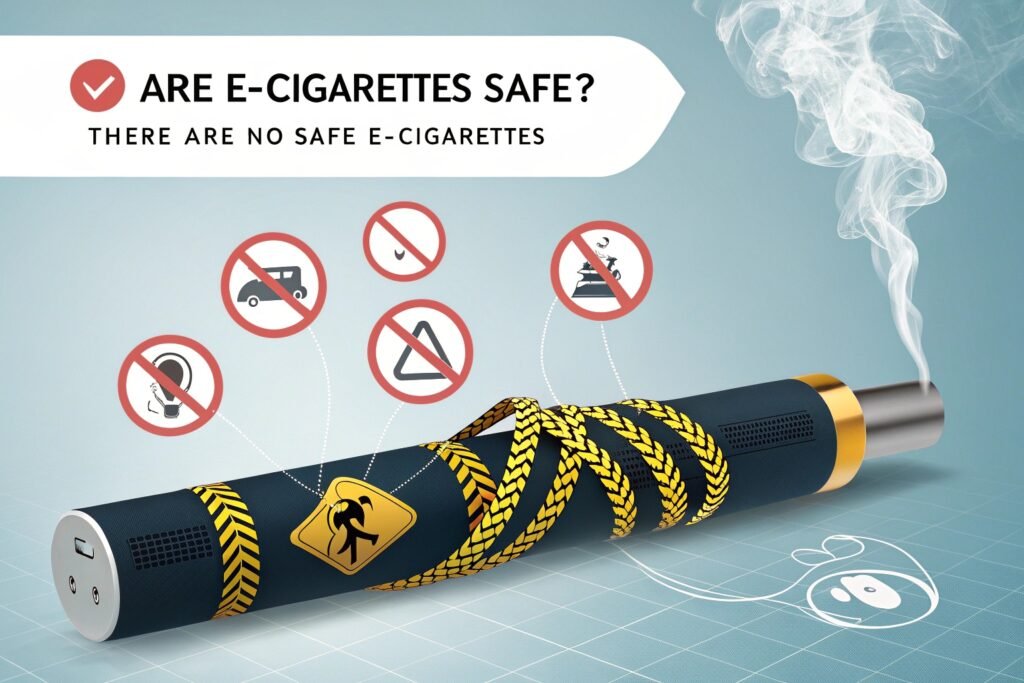 "A graphic showing that while vaping may be less harmful than smoking, it is still not a safe activity"
"A graphic showing that while vaping may be less harmful than smoking, it is still not a safe activity"
It's crucial to understand that "less harmful" doesn't equal "safe."
The potential benefits of e-cigarettes as a harm reduction tool for smokers are a subject of ongoing debate and research. Drawing from my understanding of public health and harm reduction principles, I've identified the following key arguments. The e-cigarettes may be less harmful than traditional cigarettes for existing smokers7 – e-cigarettes may be less harmful than traditional cigarettes for existing smokers, as they do not contain tobacco or produce combustion byproducts, such as tar and carbon monoxide. The e-cigarettes can help smokers transition away from traditional cigarettes8 – e-cigarettes can help smokers transition away from traditional cigarettes by providing a similar nicotine delivery experience without the harmful effects of combustion. The e-cigarettes may reduce exposure to harmful chemicals compared to traditional cigarettes – e-cigarettes may reduce exposure to harmful chemicals compared to traditional cigarettes, as they do not contain as many toxic substances as tobacco smoke. The e-cigarettes can be a useful tool for smokers who are unable or unwilling to quit smoking through other methods – e-cigarettes can be a useful tool for smokers who are unable or unwilling to quit smoking through other methods, providing a less harmful alternative to continued smoking. The e-cigarettes should not be used by non-smokers, youth, or pregnant women – e-cigarettes should not be used by non-smokers, youth, or pregnant women, as they can lead to nicotine addiction and other health problems.
The risks of e-cigarette use for non-smokers, youth, and pregnant women far outweigh any potential benefits. Through analyzing public health advisories and research studies, I've identified the following key risks. The nicotine addiction can lead to dependence and withdrawal symptoms9 – nicotine is a highly addictive substance that can lead to dependence and withdrawal symptoms, such as cravings, irritability, and anxiety. The exposure to harmful chemicals can damage the respiratory system – vaping exposes users to harmful chemicals, such as formaldehyde and acrolein, which can damage the respiratory system and increase the risk of lung disease. The e-cigarettes can serve as a gateway to traditional cigarettes for youth – e-cigarettes can serve as a gateway to traditional cigarettes for youth, increasing their risk of becoming addicted to nicotine and developing smoking-related diseases. The nicotine can harm brain development in adolescents and young adults – nicotine can harm brain development in adolescents and young adults, potentially leading to cognitive and behavioral problems. The e-cigarette use during pregnancy can harm the developing fetus – e-cigarette use during pregnancy can harm the developing fetus, potentially leading to birth defects, premature birth, and low birth weight.
The resources available to help people quit smoking or vaping include healthcare professionals, support groups, and nicotine replacement therapies. Through analyzing public health resources and expert recommendations, I've identified the following key resources. The healthcare professionals can provide personalized advice and support for quitting smoking or vaping – healthcare professionals can provide personalized advice and support for quitting smoking or vaping, helping individuals develop a plan that meets their specific needs. The support groups offer peer support and encouragement for people trying to quit – support groups offer peer support and encouragement for people trying to quit, providing a sense of community and shared experience. The nicotine replacement therapies (NRTs), such as patches, gum, and lozenges, can help reduce nicotine cravings and withdrawal symptoms – nicotine replacement therapies (NRTs), such as patches, gum, and lozenges, can help reduce nicotine cravings and withdrawal symptoms, making it easier to quit smoking or vaping. The medications, such as bupropion and varenicline, can help reduce nicotine cravings and withdrawal symptoms – medications, such as bupropion and varenicline, can help reduce nicotine cravings and withdrawal symptoms, making it easier to quit smoking or vaping. The quit lines and online resources provide information and support for people trying to quit – quit lines and online resources provide information and support for people trying to quit, offering practical tips, counseling, and encouragement.
What is the most trusted vape brand?
Trust is earned. Which brands have earned the most trust in the vape community?
**There is no single "most trusted" vape brand, as trust is subjective and varies among individuals. However, brands that consistently prioritize product quality, safety, and transparency tend to be more trusted. Look for brands with:
- Positive customer reviews
- Industry recognition
- Long-standing presence in the market
- Active engagement with the vape community.**
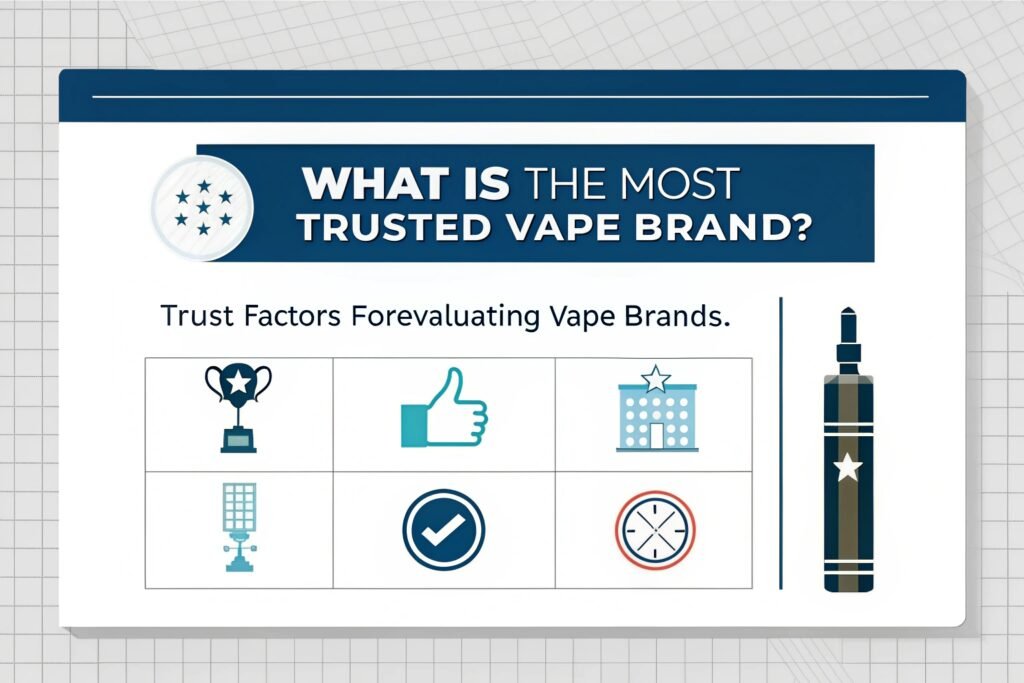 "A collection of logos from various vape brands that are generally well-regarded in the industry"
"A collection of logos from various vape brands that are generally well-regarded in the industry"
Ultimately, the "most trusted" brand is the one that best meets your individual needs and preferences.
The factors that contribute to the trustworthiness and reputation of a vape brand are multifaceted, encompassing product quality10, customer service11, and ethical business practices12. Drawing from my understanding of consumer behavior and brand management, I've identified the following key determinants. The product quality and reliability build trust with consumers – brands that consistently deliver high-quality and reliable products build trust with consumers, who are more likely to purchase their products again. The customer service and support ensure customer satisfaction – excellent customer service and support ensure customer satisfaction, resolving issues quickly and efficiently and building long-term relationships with customers. The transparent and honest communication practices foster trust and credibility – transparent and honest communication practices foster trust and credibility, allowing consumers to make informed decisions about the products they use. The ethical business practices and social responsibility demonstrate a commitment to the well-being of customers and the community – ethical business practices and social responsibility demonstrate a commitment to the well-being of customers and the community, enhancing the brand's reputation and building goodwill. The positive reviews and testimonials from satisfied customers enhance brand credibility – positive reviews and testimonials from satisfied customers enhance brand credibility, influencing potential customers to choose the brand's products.
The potential red flags to watch out for when evaluating a vape brand include lack of transparency, misleading marketing claims, and negative customer reviews. Through analyzing consumer feedback and industry reports, I've identified the following key warning signs. The lack of transparency about ingredients and manufacturing processes raises concerns about product safety – a lack of transparency about ingredients and manufacturing processes raises concerns about product safety, as consumers are unable to make informed choices about the products they use. The misleading marketing claims about the health benefits of vaping can be deceptive and harmful – misleading marketing claims about the health benefits of vaping can be deceptive and harmful, as they may lead consumers to believe that vaping is a safe activity. The negative customer reviews and complaints about product quality or customer service indicate potential problems – negative customer reviews and complaints about product quality or customer service indicate potential problems, suggesting that the brand may not be delivering on its promises. The failure to comply with safety standards and regulations raises concerns about product safety – a failure to comply with safety standards and regulations raises concerns about product safety, as the brand may be cutting corners to save money. The association with controversial practices or products can damage the brand's reputation – an association with controversial practices or products, such as marketing to youth or promoting flavored e-liquids, can damage the brand's reputation and erode trust.
The importance of doing your own research and reading reviews before choosing a vape brand cannot be overstated. Through analyzing consumer behavior and online resources, I've identified the following key strategies. The reading reviews from multiple sources to get a balanced perspective – reading reviews from multiple sources provides a balanced perspective, allowing consumers to weigh the pros and cons of different brands and products. The checking for third-party certifications and testing reports to verify product quality and safety – checking for third-party certifications and testing reports verifies product quality and safety, providing consumers with assurance that the product has been independently tested and verified. The looking for brands that are transparent about their ingredients and manufacturing processes – looking for brands that are transparent about their ingredients and manufacturing processes allows consumers to make informed choices about the products they use. The considering the brand's reputation and history in the industry – considering the brand's reputation and history in the industry can provide insights into its commitment to quality and customer satisfaction. The ultimately, trusting your own judgment and choosing a brand that meets your individual needs and preferences – ultimately, trusting your own judgment and choosing a brand that meets your individual needs and preferences is the best way to ensure a satisfying vaping experience.
Conclusion
There's no "safest" e-cigarette brand, and all vapes carry risks. Focus on brands that prioritize transparency, safety features, and quality. Remember, quitting smoking or vaping is always the safest option.
-
Understanding the importance of ingredient transparency can help consumers make safer choices when selecting e-cigarettes. ↩
-
Exploring third-party testing can provide insights into product safety and quality assurance for consumers. ↩
-
Consulting healthcare professionals can offer personalized advice and strategies for safer vaping or quitting altogether. ↩
-
Understanding the harmful chemicals in vaping can help you make informed decisions about your health and safety. ↩
-
Exploring the effects of nicotine addiction can provide insights into the risks associated with vaping and help you understand its impact on health. ↩
-
Learning about the long-term health effects of vaping is crucial for anyone considering or currently using vaping products. ↩
-
Explore this resource to understand the comparative risks and benefits of e-cigarettes versus traditional smoking, backed by research. ↩
-
This link will provide insights into how e-cigarettes can serve as a tool for smoking cessation, enhancing your understanding of harm reduction. ↩
-
Learn more about the serious implications of nicotine addiction, including withdrawal symptoms, to better understand the risks involved. ↩
-
Understanding product quality is crucial for making informed choices about vape brands. Explore this link to learn more about quality indicators. ↩
-
Customer service plays a vital role in brand loyalty. Discover insights on how it affects consumer trust in vape brands. ↩
-
Ethical practices are essential for brand credibility. Learn about the importance of ethics in the vape industry and its impact on reputation. ↩






